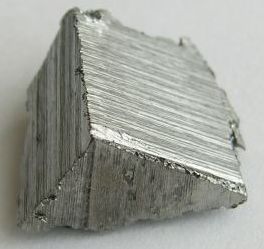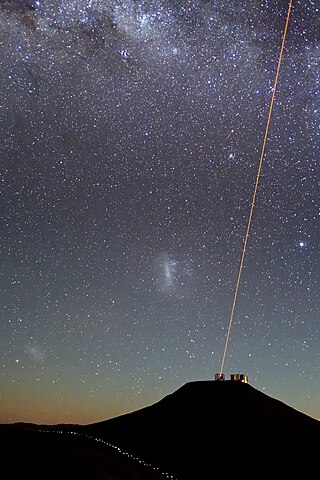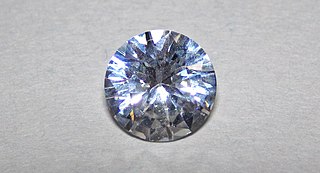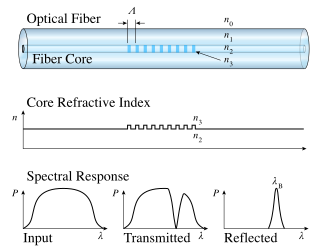Related Research Articles

Erbium is a chemical element; it has symbol Er and atomic number 68. A silvery-white solid metal when artificially isolated, natural erbium is always found in chemical combination with other elements. It is a lanthanide, a rare-earth element, originally found in the gadolinite mine in Ytterby, Sweden, which is the source of the element's name.

A laser is a device that emits light through a process of optical amplification based on the stimulated emission of electromagnetic radiation. The word laser is an anacronym that originated as an acronym for light amplification by stimulated emission of radiation. The first laser was built in 1960 by Theodore Maiman at Hughes Research Laboratories, based on theoretical work by Charles H. Townes and Arthur Leonard Schawlow.

Ytterbium is a chemical element; it has symbol Yb and atomic number 70. It is a metal, the fourteenth and penultimate element in the lanthanide series, which is the basis of the relative stability of its +2 oxidation state. Like the other lanthanides, its most common oxidation state is +3, as in its oxide, halides, and other compounds. In aqueous solution, like compounds of other late lanthanides, soluble ytterbium compounds form complexes with nine water molecules. Because of its closed-shell electron configuration, its density, melting point and boiling point are much lower than those of most other lanthanides.

An optical amplifier is a device that amplifies an optical signal directly, without the need to first convert it to an electrical signal. An optical amplifier may be thought of as a laser without an optical cavity, or one in which feedback from the cavity is suppressed. Optical amplifiers are important in optical communication and laser physics. They are used as optical repeaters in the long distance fiber-optic cables which carry much of the world's telecommunication links.

In the field of optics, transparency is the physical property of allowing light to pass through the material without appreciable scattering of light. On a macroscopic scale, the photons can be said to follow Snell's law. Translucency allows light to pass through, but does not necessarily follow Snell's law; the photons can be scattered at either of the two interfaces, or internally, where there is a change in index of refraction. In other words, a translucent material is made up of components with different indices of refraction. A transparent material is made up of components with a uniform index of refraction. Transparent materials appear clear, with the overall appearance of one color, or any combination leading up to a brilliant spectrum of every color. The opposite property of translucency is opacity. Other categories of visual appearance, related to the perception of regular or diffuse reflection and transmission of light, have been organized under the concept of cesia in an order system with three variables, including transparency, translucency and opacity among the involved aspects.

Yttrium aluminium garnet (YAG, Y3Al5O12) is a synthetic crystalline material of the garnet group. It is a cubic yttrium aluminium oxide phase, with other examples being YAlO3 (YAP) in a hexagonal or an orthorhombic, perovskite-like form, and the monoclinic Y4Al2O9 (YAM).
Saturable absorption is a property of materials where the absorption of light decreases with increasing light intensity. Most materials show some saturable absorption, but often only at very high optical intensities. At sufficiently high incident light intensity, the ground state of a saturable absorber material is excited into an upper energy state at such a rate that there is insufficient time for it to decay back to the ground state before the ground state becomes depleted, causing the absorption to saturate. The key parameters for a saturable absorber are its wavelength range, its dynamic response, and its saturation intensity and fluence.

A fiber Bragg grating (FBG) is a type of distributed Bragg reflector constructed in a short segment of optical fiber that reflects particular wavelengths of light and transmits all others. This is achieved by creating a periodic variation in the refractive index of the fiber core, which generates a wavelength-specific dielectric mirror. Hence a fiber Bragg grating can be used as an inline optical filter to block certain wavelengths, can be used for sensing applications, or it can be used as wavelength-specific reflector.
Sir David Neil Payne CBE FRS FREng is a British professor of photonics who is director of the Optoelectronics Research Centre at the University of Southampton. He has made several contributions in areas of optical fibre communications over the last fifty years and his work has affected telecommunications and laser technology. Payne’s work spans diverse areas of photonics, from telecommunications and optical sensors to nanophotonics and optical materials, including the introduction of the first optical fibre drawing tower in a university.

A solid-state laser is a laser that uses a gain medium that is a solid, rather than a liquid as in dye lasers or a gas as in gas lasers. Semiconductor-based lasers are also in the solid state, but are generally considered as a separate class from solid-state lasers, called laser diodes.

An optical fiber, or optical fibre, is a flexible glass or plastic fiber that can transmit light from one end to the other. Such fibers find wide usage in fiber-optic communications, where they permit transmission over longer distances and at higher bandwidths than electrical cables. Fibers are used instead of metal wires because signals travel along them with less loss and are immune to electromagnetic interference. Fibers are also used for illumination and imaging, and are often wrapped in bundles so they may be used to carry light into, or images out of confined spaces, as in the case of a fiberscope. Specially designed fibers are also used for a variety of other applications, such as fiber optic sensors and fiber lasers.
Ytterbium-doped lutetium orthovanadate, typically abbreviated Yb:LuVO4, is an active laser medium. The peak absorption cross section for the pi-polarization is 8.42×10−20 cm2 at 985 nm, and the stimulated emission cross section at 1020 nm is 1.03×10−20 cm².
A fiber laser is a laser in which the active gain medium is an optical fiber doped with rare-earth elements such as erbium, ytterbium, neodymium, dysprosium, praseodymium, thulium and holmium. They are related to doped fiber amplifiers, which provide light amplification without lasing.
3D optical data storage is any form of optical data storage in which information can be recorded or read with three-dimensional resolution.
A dopant is a small amount of a substance added to a material to alter its physical properties, such as electrical or optical properties. The amount of dopant is typically very low compared to the material being doped.

Photon upconversion (UC) is a process in which the sequential absorption of two or more photons leads to the emission of light at shorter wavelength than the excitation wavelength. It is an anti-Stokes type emission. An example is the conversion of infrared light to visible light. Upconversion can take place in both organic and inorganic materials, through a number of different mechanisms. Organic molecules that can achieve photon upconversion through triplet-triplet annihilation are typically polycyclic aromatic hydrocarbons (PAHs). Inorganic materials capable of photon upconversion often contain ions of d-block or f-block elements. Examples of these ions are Ln3+, Ti2+, Ni2+, Mo3+, Re4+, Os4+, and so on.
When optical fibers are exposed to ionizing radiation such as energetic electrons, protons, neutrons, X-rays, Ƴ-radiation, etc., they undergo 'damage'. The term 'damage' primarily refers to added optical absorption, resulting in loss of the propagating optical signal leading to decreased power at the output end, which could lead to premature failure of the component and or system.
Judith M. Dawes is an Australian physicist who is Professor of Physics at Macquarie University. She studies the interactions of light at the nanoscale and the applications of lasers in sensing. She is a former president of the Australian Optical Society, and a Fellow of SPIE and Optica.
Laser-induced white emission (LIWE) is a broadband light in the visible spectral range. This phenomenon was reported for the first time by Jiwei Wang and Peter Tanner in 2010 for fully concentrated lanthanide oxides in vacuum, excited by a focused beam of infrared laser diode operating in continuous wave (CW) mode. The white light emission intensity is exponentially dependent on excitation power density and pressure surrounding the samples. It was found that light emission is assisted by photocurrent generation and hot electron emission.
Arsenic(III) telluride is an inorganic compound with the chemical formula As2Te3. It exists in two forms, the monoclinic α phase which transforms under high pressure to a rhombohedral β phase. The compound is a semiconductor, with most current carried by holes. Arsenic telluride has been examined for its use in nonlinear optics.
References
- ↑ J. Koponen; M. Söderlund; H.J. Hoffman; D. Kliner; J. Koplow; J.L. Archambault; L. Reekie; P.St.J. Russell; D.N. Payne (2007). "Photodarkening measurements in large mode area fibers". Proceedings of SPIE. 6553 (5): 783–9. Bibcode:2007SPIE.6453E..40K. doi:10.1117/12.712545. S2CID 27204182.[ dead link ]
- 1 2 L. Dong; J. L. Archambault; L. Reekie; P. St. J. Russell; D. N. Payne (1995). "Photoinduced absorption change in germanosilicate preforms: evidence for the color-center model of photosensitivity". Applied Optics. 34 (18): 3436–40. Bibcode:1995ApOpt..34.3436D. doi:10.1364/AO.34.003436. PMID 21052157.
- ↑ N. Li; S. Yoo; X. Yu; D. Jain; J. K. Sahu (2014)“Pump Power Depreciation by Photodarkening in Ytterbium-Doped Fibers and Amplifiers”, IEEE Photonics Technology Letters, Vol. 26, Issue 2, pp.115-118
- ↑ "Encyclopedia of Laser Physics and Technology - photodarkening, photochromic damage, photo-induced loss, ultraviolet, gray tracking, color centers".
- ↑ L.C. Courrol; I.M. Ranieri; W.B. Izilda; S.L. Baldochi; R.E. Ricardo; A.Z. de Freitas; L. Gomes; N.D.J. Vieira (2007). "Study of color centers produced in thulium doped YLF crystals irradiated by electron beam and femtosecond laser pulses". Optics Communications. 270 (2): 340–342. Bibcode:2007OptCo.270..340C. doi:10.1016/j.optcom.2006.09.071.
- 1 2 J.-F.Bisson; Kouznetsov, Dmitrii; Ueda, Ken-Ichi; Fredrich-Thornton, Susanne T.; Petermann, Klaus; Huber, Guenter; et al. (2007). "Switching of emissivity and photoconductivity in highly doped Yb3+:Y2O3 and Lu2O3 ceramics". Applied Physics Letters. 90 (20): 066101. Bibcode:2007ApPhL..90t1901B. doi:10.1063/1.2739318.
- ↑ R. Peretti; A-M. Jurdyc; B. Jacquier; Cédric Gonnet; Alain Pastouret; Ekaterina Burov; Olivier Cavani (2010). "How do traces of thulium can explain photodarkening in Yb doped fibers?". Optics Express. 18 (19): 20455–20460. Bibcode:2010OExpr..1820455P. doi: 10.1364/OE.18.020455 . PMID 20940938.
- ↑ S. Taccheo; H. Gebavi; D. Tregoat; T. Robin; B. Cadier; D. Milanese; L. Leick (2012). "Photodarkening: measure, characterization, and figure of merit" (PDF). SPIE Newsroom. doi:10.1117/2.1201209.004387. S2CID 65488451. Archived from the original (PDF) on 2019-12-30.